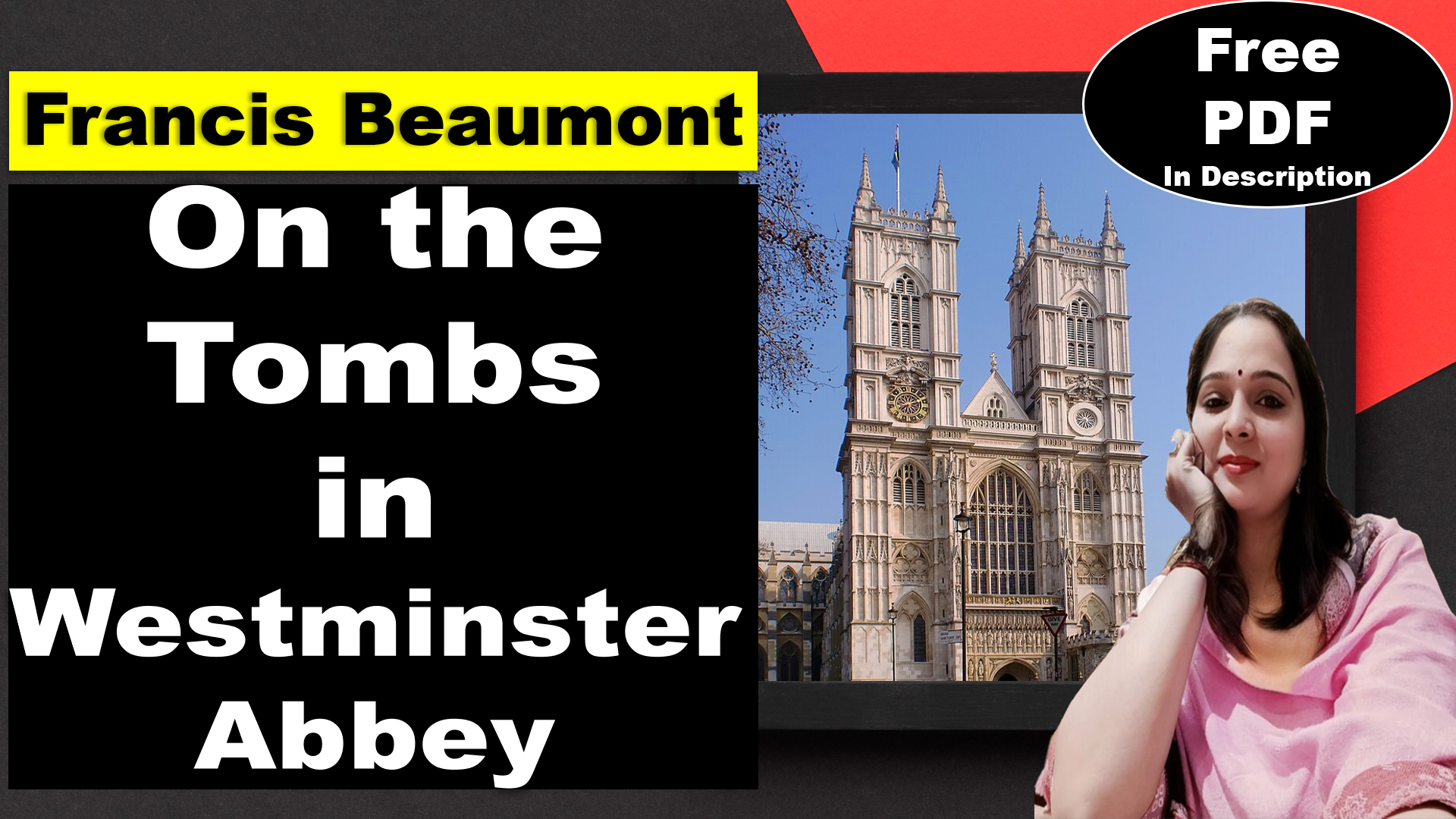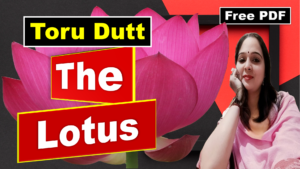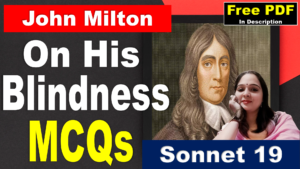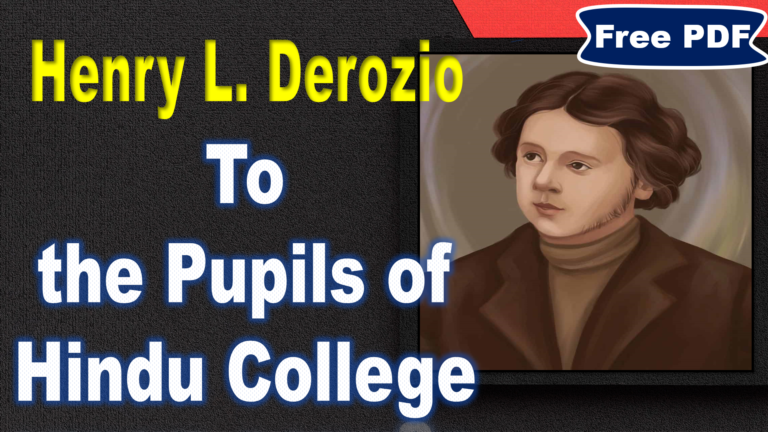On the Tombs in Westminster Abbey Poem by Francis Beaumont | On the Tombs in Westminster Abbey | Francis Beaumont | Explanation | Summary | Key Points | Word Meaning | Questions Answers | Free PDF Download – Easy Literary Lessons
On the Tombs in Westminster Abbey
MORTALITY, behold and fear!
What a change of flesh is here!
Think how many royal bones
Sleep within this heap of stones:
Here they lie had realms and lands,
Who now want strength to stir their hands:
Where from their pulpits seal’d with dust
They preach, ‘In greatness is no trust.’
Here ‘s an acre sown indeed
With the richest, royall’st seed
That the earth did e’er suck in
Since the first man died for sin:
Here the bones of birth have cried—
‘Though gods they were, as men they died.’
Here are sands, ignoble things,
Dropt from the ruin’d sides of kings;
Here ‘s a world of pomp and state,
Buried in dust, once dead by fate.
line-by-line explanation of the poem
MORTALITY, behold and fear!
What a change of flesh is here!
Explanation
This opening line personifies Mortality, addressing it directly and urging us to confront and be afraid of its power. It also draws attention to the dramatic transformation that death inflicts on our physical bodies.
Personification: Mortality is personified as a force to be seen and feared. This makes the abstract concept of death more tangible and impactful.
Think how many royal bones
Sleep within this heap of stones:
Here they lie had realms and lands,
Who now want strength to stir their hands:
Explanation
This sentence reflects on the impermanence of power and wealth. It asks us to ponder the countless rulers who once possessed vast territories but are now reduced to mere bones under a pile of stones, unable even to move their hands.
Poetic Device
Metaphor: “Sleep within this heap of stones” is a metaphor for death, comparing the burial ground to a place of slumber.
Irony: Highlighting the contrast between the past power of those with realms and lands and their current lack of strength.
Where from their pulpits seal’d with dust
They preach, ‘In greatness is no trust.’
Explanation
This line uses the image of dusty, abandoned pulpits to represent the fallen positions of power. It suggests that even those who once preached about the unreliability of greatness have themselves become victims of its impermanence.
Poetic Device
Personification: Describing the pulpits as if they have the ability to preach, adding a human-like quality to inanimate objects.
Here ’s an acre sown indeed
With the richest, royall’st seed
That the earth did e’er suck in
Since the first man died for sin:
Explanation
This sentence employs a powerful metaphor, comparing the burial ground to an acre sown with the “richest, royall’st seed.” It emphasizes that even the most noble and influential individuals ultimately meet the same fate as everyone else and return to the earth.
Poetic Device
Metaphor: Comparing the burial ground to a cultivated acre and the buried individuals to rich and royal seeds.
Alliteration: The repetition of the ‘r’ sound in “richest” and “royall’st” creates a rhythmic flow.
Hyperbole: Calling the buried people the “richest, royall’st seed” is an exaggeration that emphasizes their former importance.
Here the bones of birth have cried—
‘Though gods they were, as men they died.’
Explanation
This line highlights the universality of death. It states that even those who were revered as gods during their lives are ultimately reduced to mere bones in death, proving their human mortality.
Poetic Device
Personification: Giving human qualities to bones, suggesting that they can cry out.
Paradox: Highlighting the contradiction that, despite being considered gods, these individuals died as mortals.
Here are sands, ignoble things,
Dropt from the ruin’d sides of kings;
Explanation
This sentence compares the once-powerful kings to insignificant grains of sand, emphasizing their complete downfall. It underscores the transient nature of power and the inevitable decay that awaits everyone.
Poetic Device
Metaphor: This sentence uses metaphor by comparing the remains of the kings to sands
Here ’s a world of pomp and state,
Buried in dust, once dead by fate.
Explanation
This final line provides a somber conclusion, summarizing the entire scene. It describes the burial ground as a once-grand world of pomp and state, now reduced to dust and forgotten by fate. It serves as a reminder of the impermanence of earthly glory and the ultimate power of death.
Poetic Device
Alliteration: alliteration with the repetition of the ‘d’ sound in “dead by dust”.
Summary
The poem is “On the Tombs in Westminster Abbey” by Francis Beaumont. Francis Beaumont (1584-1616) was an English dramatist and poet, best known for his collaboration with John Fletcher on plays during the Jacobean era.
In this poem, Beaumont reflects on the mortality of human beings, especially the powerful and royal figures who are now laid to rest in Westminster Abbey. The verses convey a sense of the transience of earthly greatness, emphasizing that even those who once held realms and lands now lie in stillness, unable to exert any strength.
The poet draws attention to the contrast between the past grandeur of these individuals and their current state as lifeless bones in a heap of stones. The notion that even gods, as powerful as they may have been in their time, succumbed to mortality and died as men is also emphasized.
The imagery of an “acre sown” with the richest and royal seed symbolizes the burial ground, and the mention of “sands, ignoble things” dropped from the sides of kings reinforces the idea of the fallen and decayed state of once-majestic rulers. The poem reflects on the inevitable fate of all, regardless of their past glory, as they are buried in dust and reduced to insignificance by the passage of time.
Key Points
Author Francis Beaumont (1584-1616) was an English poet and playwright.
Form The poem follows a rhyme scheme of AABBCCDDEEFFGGHHII and is written in iambic tetrameter.
Speaker The speaker in the poem is an observer reflecting on the mortality and the transience of earthly power and wealth.
Setting The setting of the poem is Westminster Abbey, a notable burial site in London.
Theme The central theme of the poem is the inevitability of death and the transience of earthly power and wealth.
Plot The poem begins with the speaker addressing mortality and reflecting on the change that death brings. The speaker contemplates the bones of once-powerful rulers who now lie in graves, unable to move or speak. The final lines describe a world of “pomp and state” buried in dust and forgotten by fate.
Tone The tone of the poem is somber and reflective, inviting the reader to contemplate the transience of life and the inevitability of death.
Style Simple and direct language, with occasional use of metaphor and personification . The rhyme scheme contribute to a sense of order and formality, reflecting the solemnity of the setting.
Message The message of the poem is a reminder of our mortality and the fleeting nature of power and wealth. No matter how great or powerful someone may be in life, they will ultimately end up buried in dust like everyone else.
Francis Beaumont
Birth and Early Life Francis Beaumont was born around 1584 in Grace-Dieu, Leicestershire, England.
Education He was educated at Broadgates Hall (now Pembroke College), Oxford.
Career Beaumont was a dramatist in the English Renaissance theatre.
He is most famous for his collaborations with John Fletcher on comedies and tragedies between about 1606 and 1613.
His first work, “Salmacis and Hermaphroditus”, appeared in 1602.
His solo work, “The Knight of the Burning Pestle”, was first performed by the Children of the Blackfriars in 1607.
Personal Life Around 1613, Beaumont married Ursula Isley, daughter and co-heiress of Henry Isley of Sundridge in Kent.
They had two daughters, Elizabeth and Frances.
Death Beaumont died on March 6, 1616, in London.
Legacy It is believed that Beaumont’s hand appears in 10 plays published in 1647 as by “Beaumont and Fletcher” and in 3 plays substantially written by Fletcher and Philip Massinger.
“The Knight of the Burning Pestle” is considered Beaumont’s unaided work.
Word Meaning
| Line | Tough Word | Meaning in English | Meaning in Hindi |
| 1 | Mortality | State of being subject to death | मृत्युता |
| 1 | Behold | To observe or look at | देखना |
| 2 | Flesh | The soft tissue of a person or animal’s body | मांस |
| 4 | Heap | A large and untidy collection of things | ढेर |
| 5 | Realms | Kingdoms, territories | साम्राज्य |
| 6 | Stir | Move slightly | हिलाना |
| 7 | Pulpits | Elevated platforms or lecterns in a church from which a preacher delivers a sermon | पुल्पिट |
| 8 | Preach | Publicize | धर्म का उपदेश देना |
| 9 | Sown | Planted, seeded | बोया |
| 10 | Royall’st | Most royal | सबसे राजकुमारी |
| 11 | Suck in | Absorb or draw in | सोखना |
| 12 | Sin | Guilt / Crime | पाप |
| 15 | Ignoble | Not honorable in character or purpose | अश्लील |
| 16 | Dropt | Dropped, fallen | गिरा |
| 17 | Ruin’d | Ruined / Destroyed | तबाह |
| 17 | Pomp and state | Extravagant display of wealth and power | धूमधाम और ऐश्वर्य |
| 18 | Buried | Placed in the ground as a dead body | दफन |
Very Short Answer Questions
Who is the author of the poem?
The author of the poem is Francis Beaumont.
What is the setting of the poem?
The setting of the poem is Westminster Abbey, a notable burial site in London.
What is the central theme of the poem?
The central theme of the poem is the inevitability of death and the transience of earthly power and wealth.
What is the tone of the poem?
The tone of the poem is somber and reflective.
What style is the poem written in?
Simple and direct language, with occasional use of metaphor and personification .
What is the message of the poem?
The message of the poem is a reminder of our mortality and the fleeting nature of power and wealth.
Who is the speaker in the poem?
The speaker in the poem is an observer reflecting on mortality and the transience of earthly power and wealth.
What is the form of the poem?
The poem follows a rhyme scheme of AABBCCDDEEFFGGHHII and is written in iambic tetrameter.
What poetic device is used in the line “MORTALITY, behold and fear!”?
The poetic device used is personification.
What does the line “Think how many royal bones Sleep within this heap of stones” imply?
It implies the mortality of even the most powerful individuals.
What does the line “Where from their pulpits seal’d with dust They preach, ‘In greatness is no trust.’” mean?
It means that the tombs serve as a reminder that one cannot place trust in worldly greatness.
What does the line “Here ’s an acre sown indeed With the richest, royall’st seed” signify?
It signifies that the tombs are filled with the remains of once powerful and wealthy individuals.
What does the line “Here the bones of birth have cried— ‘Though gods they were, as men they died.’” convey?
It conveys that despite their god-like status in life, these individuals met the same fate as all humans – death.
What does the line “Here are sands, ignoble things, Dropt from the ruin’d sides of kings;” mean?
It means that the remains of the kings have been reduced to mere dust.
What does the line “Here ’s a world of pomp and state, Buried in dust, once dead by fate.” imply?
It implies that the grandeur and status that these individuals once enjoyed are now buried and returned to dust.
What is the mood of the speaker in the poem?
The mood of the speaker varies throughout the poem.
Short Answer Questions
1. What is the significance of the setting in the poem?
The poem is set in Westminster Abbey, a notable burial site in London. This setting is significant as it houses the tombs of many powerful and influential individuals, serving as a stark reminder of mortality and the fleeting nature of earthly power and wealth.
2. How does the author use imagery in the poem?
Beaumont uses vivid imagery to convey the themes of the poem. He describes the tombs as “pulpits sealed with dust” and the remains of the kings as “sands”, creating a vivid picture of death and decay.
3. What is the central message of the poem?
The central message of the poem is a reminder of our mortality and the fleeting nature of power and wealth. Despite the greatness and wealth one might achieve in life, everyone meets the same fate in death.
4. How does the author convey the theme of mortality in the poem?
Beaumont conveys the theme of mortality through the use of vivid imagery and metaphors. He describes the tombs as “pulpits sealed with dust” and the remains of the kings as “sands”, reminding the reader of the inevitability of death.
5. What is the tone of the poem and how does it contribute to the overall meaning?
The tone of the poem is somber and reflective. This tone invites the reader to contemplate the transience of life and the inevitability of death, reinforcing the poem’s central themes.
6. How does the author use personification in the poem?
Beaumont uses personification in several instances in the poem. For example, he addresses mortality as if it were a person and suggests that the tombs are preaching a lesson.
7. What is the significance of the line “Here ’s an acre sown indeed With the richest, royall’st seed”?
This line is significant as it uses the metaphor of sowing seeds in an acre to describe the burial of the once powerful and wealthy individuals. It underscores the theme of the transience of earthly power and wealth.
8. How does the author use alliteration in the poem?
Beaumont uses alliteration in the line “Here ’s a world of pomp and state, Buried in dust, once dead by fate.” The repetition of the ‘d’ sound in “dead by dust” adds a rhythmic quality to the line and emphasizes the theme of death.
9. What is the significance of the line “Though gods they were, as men they died”?
This line is significant as it underscores the theme of the poem – the inevitability of death. Despite their god-like status in life, these individuals met the same fate as all humans – death.
10. How does the poem reflect on the concept of power and wealth?
The poem reflects on the concept of power and wealth by highlighting their fleeting nature. It underscores the idea that no matter how much power or wealth one accumulates in life, death is the great equalizer.
Essay Type Questions
1. Write the critical appreciation of the poem.
Introduction Francis Beaumont’s “On the Tombs in Westminster Abbey” is a poignant reflection on mortality and the fleeting nature of earthly power and wealth. The poem, set in the historic Westminster Abbey, uses vivid imagery and thoughtful metaphors to convey its themes.
Theme The central theme of the poem is the inevitability of death and the transience of power and wealth. Beaumont underscores the idea that regardless of one’s status or accomplishments in life, death is the great equalizer. This theme is a common one in literature and philosophy, reflecting the universal human experience of mortality.
Setting The setting of the poem is Westminster Abbey, a notable burial site in London. This setting is significant as it houses the tombs of many powerful and influential individuals, serving as a stark reminder of mortality and the fleeting nature of earthly power and wealth. The Abbey, with its centuries-old tombs, provides a tangible connection to the past, reminding us of the transient nature of life.
Form and Structure The poem follows a rhyme scheme of AABBCCDDEEFFGGHHII and is written in iambic tetrameter. This form and structure lend a rhythmic quality to the poem, making it pleasing to the ear while also reinforcing its themes. The use of a single stanza suggests a continuous, unbroken reflection on death and mortality.
Imagery and Symbolism Beaumont uses vivid imagery to convey the themes of the poem. He describes the tombs as “pulpits sealed with dust” and the remains of the kings as “sands”, creating a vivid picture of death and decay. These images serve to underscore the themes of mortality and the transience of power and wealth. The “pulpits sealed with dust” symbolize the silenced voices of the once-powerful, while the “sands” symbolize the reduced state of the kings in death.
Tone and Mood The tone of the poem is somber and reflective. This tone invites the reader to contemplate the transience of life and the inevitability of death, reinforcing the poem’s central themes. The mood of the poem is similarly somber, reflecting the serious and contemplative nature of the subject matter.
Conclusion In conclusion, “On the Tombs in Westminster Abbey” is a powerful reflection on mortality and the fleeting nature of earthly power and wealth. Through vivid imagery, thoughtful metaphors, and a somber tone, Beaumont invites the reader to contemplate the transience of life and the inevitability of death. The poem serves as a reminder of our shared mortality, underscoring the idea that regardless of our achievements in life, we all meet the same fate in death.










